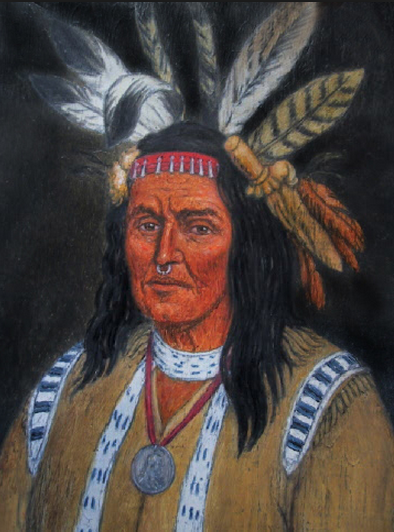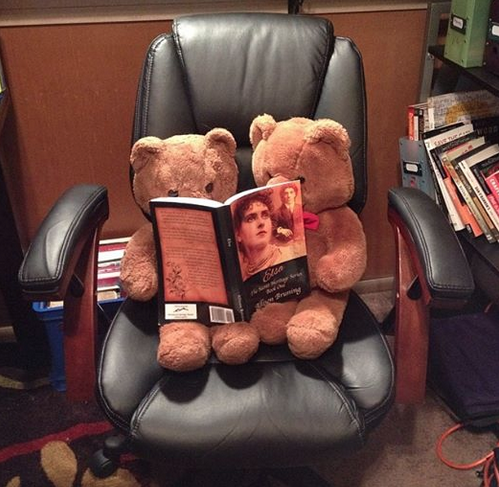Allison Bruning's Blog, page 18
July 9, 2014
#HeSaidWhat: Little Owl, warrior, husband, father, passionate lover!
Published on July 09, 2014 22:00
#QuoteMeThursday: Illegal to be #Irish? #Ireland #hisfic
Published on July 09, 2014 21:00
July 7, 2014
Who Are The #Shawnee: A Tale of Two Chiefs #NativeAmerica #Ohio
 Shawnee
Shawnee
The very word unifies them as a nation. Yet in all of Shawnee history, the only time they ever came together as one people was when there was a threat against all Shawnee people. The Shawnee have always lived an independent lifestyle. To be an adult Shawnee meant you could live wherever you wanted without the need to answer to anyone. This allowed the Shawnee the freedom to settle anywhere which is why when the settlers began to explore the wilderness it was very easy for them to run into a Shawnee.
One of the problems the Europeans faced with the Shawnee people was the idea of political unity. The Europeans' concept of leadership was completely different than the Shawnee. They were coming for a culture where monarchy was the rule of the land. This meant everyone obeyed one leader. To the Shawnee this was a foreign concept. While they did have chiefs, they could leave the chief's leadership if they disagreed with the chief. So when a chief makes an agreement with another he is speaking for his village but if a person does not agree with the comprise he or she is free to leave without any political repercussions. The Europeans had expected if a compromise was made with a Shawnee chief then it was to be followed by all Shawnee. In the Shawnee's eyes, the compromise was made only with his or her village not the entire nation. The cultural differences in this belief often mistakenly lead the Europeans in conflict with the Shawnee.
Ideally the leadership of a village was lead under two chiefs, the peace chief and the war chief. The two did not come from the same division nor did they lead their people at the same time. Shawnee division were: Chillicothe (Chalahgawtha) [Chalaka, Chalakatha], Hathawekela (Asswikales, Sweickleys, etc.) [Thawikila], Kispokotha (Kispoko) [kishpoko, kishpokotha], Mequachake (Mekoche, Machachee, Maguck, Mackachack) [Mekoche] and Pekuwe (Piqua, Pekowi, Pickaway, Picks) [Pekowi, Pekowitha]. All villages had a council of elders that were like advisers to the chief. No chief could make a decision without seeking the advice of the elders. Council meetings were often held for three days.
The Peace Chief
 The peace chief came from the Chillicothe division. He was responsible for leading the village in times of peace and only answered to the principal peace chief. The principal peace chief was the peace leader over of all the Shawnee. Each summer the village peace chiefs would travel to the principal peace chief's village for a great council. The position of peace chief was hereditary. It could only be passed from father to son. The principal chief was chosen from the independent village chiefs. A famous Shawnee peace chief was Chief Cornstalk.
The peace chief came from the Chillicothe division. He was responsible for leading the village in times of peace and only answered to the principal peace chief. The principal peace chief was the peace leader over of all the Shawnee. Each summer the village peace chiefs would travel to the principal peace chief's village for a great council. The position of peace chief was hereditary. It could only be passed from father to son. The principal chief was chosen from the independent village chiefs. A famous Shawnee peace chief was Chief Cornstalk. The peace chief's wife was known as the female peace chief. She had the responsibility of overseeing the female duties of the village, ordering when to plant and sow the fields and scheduled the cooking for the feasts. Women had a strong voice in the tribal government because the Shawnee honored women more than men.
The War ChiefOne of the most well-known war chiefs was Tecumseh.
The position of war chief was not hereditary. After the war chief died any Kishpoko could compete for the position. The competitors were given men underneath their leadership for the duration of three seperate village attacks. They had to prove themselves by gathering a scalp from each attack and arrive home without any of their warriors killed or injured. Than the man who could do this three times was said to be chosen by Our Grandmother to replace the war chief. A war chief could only come out of the Kishpoko division since these were the warriors of the Shawnee nation. Tecumseh's father was the principal war chief until his death when Tecumseh was still a boy. Tecumseh was too young at that time to fight for his father's position.
The war chief led the village during the times of war. He was also responsible for training all boys to become warriors and strong providers. Whenever the village was at war it would be the war chief who was in charge and not the peace chief. You could always tell the distinction between the chiefs because a war chief always wore a red tipped tomahawk on his hip. The war chief, like the peace chief, also answered to a principal chief and travelled in the summer to the a great council. Another responsibility of the war chief was to ensure law and order in the village. He was the emissary sent to other tribes to speak on behalf of his village. So more often, the Europeans, when they were encountering a village leader it was not the peace chief they were speaking too but the war chief. The war chief would not make a decision without consulting the peace chief first. This is why they rarely made a decision when speaking to the Europeans about anything. They would have to take the information back to the village, discuss it with the peace chief and council then deliver the decision to the tribe or Europeans. The Europeans did not understand this and often grew impatient waiting for their reply.
Like the peace chief, the war chief's wife also served beside her husband in the leadership of their people. Known as the war woman, she was responsible for examining the captives. If her husband was about to attack a village or kill a captive and she disapproved she could speak up against it. He could not act without her consent if she decided to protect them.
Published on July 07, 2014 23:00
#ExpressYourself: Inside Field of Grace #IamWriting #Marion #Ohio

This week's Express Yourself Weekly Blog Hop asks me to write the last line on page 10 and the first line on page 42 of my current work in progress or WIP. Unfortunately, I have only written 36 pages in Field of Grace so far so I will have to use page 36 instead of page 42.
Field of Grace is a historical fiction novel that is loosely based on real life events and people. It takes place in 1919 Marion County, Ohio.
Summary:
 Quilt ridden, Ida McIntyre doesn't know how she can ever win her father's approval until Jeremiah Miller poisons her family. Determined to prove her worth, Ida sets out to find help only to face Jeremiah's wrath. Faced with life and death decisions that will challenge her strength and determination, what seems to be a simple deed turns into disaster until she realizes there is hope to save not only her family but her father's approval.
Quilt ridden, Ida McIntyre doesn't know how she can ever win her father's approval until Jeremiah Miller poisons her family. Determined to prove her worth, Ida sets out to find help only to face Jeremiah's wrath. Faced with life and death decisions that will challenge her strength and determination, what seems to be a simple deed turns into disaster until she realizes there is hope to save not only her family but her father's approval.Last Line On Page 10
“But the Salvation Army?”
First Line on Page 36
The temperature around her dropped.
Published on July 07, 2014 22:00
#ExpressYourself: The Teddy Bear That Saved My Sanity #childhood #protector

Happy Tuesday, everyone. This week I will be double posting in the Express Yourself Weekly Blog Tour because I missed my post for last week. So there will be two Express Yourself Blog Posts.
Last week we were asked to tell our readers about our most beloved toy growing up. My most beloved toy is a teddy bear by the name of Honey Joe. This image best describes the relationship I have always had with Honey Joe.

I met Honey Joe during one of the most difficult times of my life. My mom and dad married when I was three years old. Their marital relationship only lasted for three years. When they divorced my mom was granted sole custody and my dad was given visitation rights. He moved to an hour north to Cleveland, Ohio. Most of the relationship I had with my dad after that was through letters and telephone conversations. He would always tell me he was coming to get me for the weekend but more times than naught my hopes were dashed because he would not show up. Like most young children whose parents divorced, I couldn't understand why my mom and dad didn't live together. I loved both of my parents and thought we should all live in the same house. Wasn't that what normal families were supposed to do?
When I was eight years old, my dad had a girlfriend named Dorothy. I never liked her because to me she wasn't my mom and in my head the only woman right for my dad was my mother. My dad broke it off with her and my parents were trying to get back together when my dad was diagnosed with Lung Cancer. The last weekend we were together in his apartment he told me not to worry. He was going to beat this and would be there to walk his little girl down the aisle when I found Mr. Right.
A few months later, my father lost his battle. I was devastated. My father had given me a stuffed dog and three QBert Books the last time I had seen him in the hospital. (He was so duped up on Morphine that he broke the nose on the dog. I still have the dog but will never have his nose repaired because I can't bear to replace that memory.) I couldn't sleep without having nightmares and I tried so hard to not forget anything about my dad because I didn't want to forget his face or the sound of his voice. My mom had remembered that I had had my eye on a teddy bear at the local store and a few days later she gave me Honey Joe.
 Honey Joe and Honey Jane Bear read one of my books. The same year I lost my father I had invited a few girls over for a plate date. I showed my friends my bedroom and introduced them to Honey Joe. One of the girls was so upset that I got the last Honey Joe Bear from the store that she grabbed the pitcher of Fruit Punch Kool-Aid and dumped the entire pitcher on my bear. My mom tried to wash it all out of his fur but Honey Joe never looked the same.
Honey Joe and Honey Jane Bear read one of my books. The same year I lost my father I had invited a few girls over for a plate date. I showed my friends my bedroom and introduced them to Honey Joe. One of the girls was so upset that I got the last Honey Joe Bear from the store that she grabbed the pitcher of Fruit Punch Kool-Aid and dumped the entire pitcher on my bear. My mom tried to wash it all out of his fur but Honey Joe never looked the same.Honey Joe Bruning is a well loved, well cherished bear. He's been everywhere with me. Vacations, camp, college, etc. He's dried my tears, heard my fears, chased away my nightmares and more. I introduced Honey Joe to my husband while we were dating. A few years after we married he found a Honey Joe Bear at yard sale that looked brand new. I was shocked. The Honey Joe Bears were made by Dankin in 1985 and were limited editions. We bought the bear and named her Honey Jane Bear. Honey Joe has moved out of our bed and took up residence with his wife. They live on my dresser but he's still always there for me when I need him.
Published on July 07, 2014 21:00
July 5, 2014
What'sUpWithAllison: Everything Changes

Welcome back to another week on my blog. This past weekend in the United States, Americans have been celebrating the 229th birthday of our country. It's been a long, wonderful weekend.
This week's news for all my readers will change everything.
My long time editor, Lee Porche, has accepted the Director of Editing position with the publishing house that I and Craig Michael Lewis own, Mountain Springs House. As such, her duties have drastically increased and she will no longer be able to edit my books.
I have found a new editor. Jasmine Dawson will be editing my previous works and my future ones. She has already edited a short story I plan to release very soon. Our next project will be the re-release of my bestselling Native American Historical Fiction book, Calico. Yet I will be making some drastic changes to the book. First, the protagonist will no longer be Calico but her husband, War Chief Little Owl Quick as the Wind. Second, we will be changing the title but not the series title. I will be certain to keep you informed of the progress. I am also currently working on the screenplay adaptation of the book.
Published on July 05, 2014 21:00
June 30, 2014
What'sUpWithAllison: #CampNaNoWriMo Here I Come!
 Good Morning!
Good Morning!I know it's Monday and I'm posting a Sunday Post. Last week was just one of those busy, busy, very busy week. This summer I have decided to take a little vacation time for myself. I've needed a vacation for so long. Sometimes you just have to put the pen down and go live. I decided to take a break from writing last week because I knew I would have to write like a mad women starting this week.
This week starts the second session of Camp NaNoWriMo. I'm so excited about it.
This month I will be focusing on writing the screenplay for my book, Calico. I estimate I will only need 30,000 words. Usually I write around 50,000 per month for NaNoWriMo and Camp NaNoWriMo.
So..........................
On your mark!
Get set!
Write!!!!
Published on June 30, 2014 04:49
June 19, 2014
#Blessings: A Terracota Warrior invasion at the Children's Museum

This week I had the one of the most amazing opportunities. I was able to scratch something off my bucket list that I thought I would have never been able to do without going to China. I've waited years, just to look face to face with a terracota warrior. You have no idea how long and hard I have dreamed of doing that.
My bucket list contains archaeological delights such as:
See the Great Wall of China
Visit the Parthenon in Greece
Climb up the stairs of Tenochtitlan
See the Leaning Tower of Pisa
See the Egyptian Sphinx
I was so excited when I saw this commercial on TV.
The Children's Museum in Indianapolis is the only place in the United States where you can see actual Terracotta warriors. They are on loan to the museum from Xi'an, China until November. Well you know I just had to go!


What is something on your bucket list?
Published on June 19, 2014 21:00
#HeSaidWhat: She's the Only One for Jesse Garrett

Jesse Garrett hasn't always lived the best of life. He's a proud family man who loves his wife and children. Yet, there is darkness in his heart caused by family tragedy and experiences he had while serving in the Civil War.

Published on June 19, 2014 01:00
June 18, 2014
#QuoteMeThursday: Open Your Eyes, Elsa

This week on the Quote Me Thursday by the Daily Mayo we turn our eyes to 1909 Marion, Ohio. Elsa is having a hard time dealing with the potential death of her older brother. Henry has collapsed and she is in the doctor's office with her family. She doesn't know what will happen to him. She is questioning whether or not to leave her brother's side in order to go on a date with Franklin. Her mother gives her sound advice.

Published on June 18, 2014 23:00





